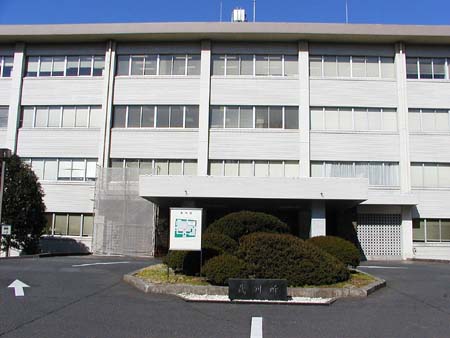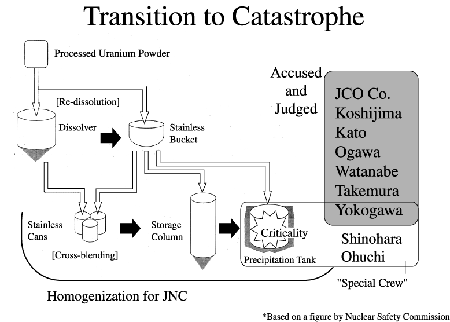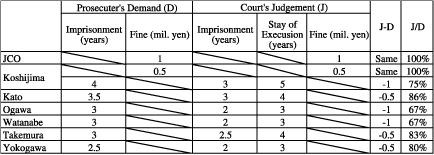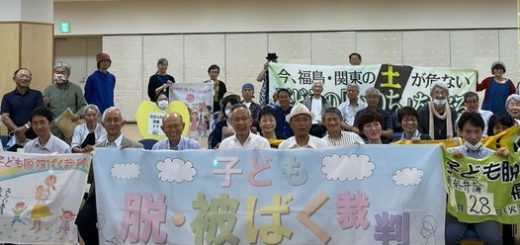Judgement on JCO Criticality Accident: Missing Links still Remain Nuke Info Tokyo No. 94
 The Mito District Court (15km from JCO in Tokaimura) where the ruling on JCO was delivered. The Mito District Court (15km from JCO in Tokaimura) where the ruling on JCO was delivered. |
||
| On the morning of March 3, the Mito District court delivered a ruling on JCO Co. (JCO), a nuclear fuel-processing plant in Tokaimura, Ibaraki Prefecture, including a judgment on former and current officials of the company.It has been three-and-a-half years since the criticality accident at JCO’s Tokai facility and just thirty days since a court ruling on the Monju FBR (see NIT 93).
The trial sought to determine responsibility for JCO’s illegal operations that led to the accident, including the death of two workers. In its ruling, the Court imposed fines on JCO and also on the former head of the Tokaimura plant. In its judgments that the Court also ordered suspended prison sentences in the case of the former head of the JCO plant and five other officials who served in management positions or as field supervisors at the time of the accident. The ruling adopted the prosecution’s claim that the cause of the accident could not be extend to include the responsibilities of other related organizations. On the other hand, the Court meted out sentences that were lighter than penalties demanded by the prosecution on the grounds that responsibility for the accident could not be restricted to the defendants being accused at the trial (following the claims of the defendants). Now that the Court has determined that there were additional causes of the criticality accident, — beyond the roles played by the defendants — it should clearly spell them out. Although the ruling stated that JCO should receive “the maximum penalty under the relevant law,” the penalty was only a one million yen fine. It included 500,000 yen fine for violation of the Law for the Regulation of Nuclear Source, Material, Nuclear Fuel Material and Reactors (Nuclear Reactor Regulation Law) and 500,000 yen fine for violation of the Law on Labor Sanita ry. Since both prosecutors and defendants did not make an appeal to the higher courts within two weeks following the Court decision, the results of the ruling case were confirmed on March 18. PNC’s Joyo and JCOJCO manufactured uranyl nitrate solution in the Conversion Test Building at the Tokai facility, which was used to produce fuels for the experimental fast reactor Joyo, owned and operated by Japan Nuclear Fuel Cycle Development Institute (JNC). JNC was formerly the Power Reactor and Nuclear Fuel Development Corporation (PNC). Therefore, uranium — which caused the criticality accident — was supposed to be loaded at Joyo’s reactor, otherwise nothing would have happened. The JCO had been manufacturing a highly enriched uranyl nitrate solution since the 1980s. The criticality accident occurred when workers at JCO attempted to homogenize the density of the solution by pouring it into the Precipitation Tank not used during normal manufacturing process. Joyo reached its criticality on April 24, 1977. However, just before criticality at Joyo, the Carter administration in the United States announced a non-proliferation policy that sought to freeze the operation of reprocessing plants and development of fast breeder reactors. Japan-United States negotiations on reprocessing policy subsequently took place. As a result of talks, Japan was prohibited from extracting plutonium powder on its own. Due to restrictions imposed by negotiations, the manufacturer, which was making mixed plutonium and uranium oxide fuels (MOX) for Joyo and other plants was required to mix a plutonium solution and a uranyl nitrate solution. A method developed by the PNC, called the “Microwave Heating Denitration” was used to de-nitrate the solution. In short, the need for manufacturing a uranyl nitrate solution (rather than a powder ) was created under such political pressure. The Joyo initially adopted the “Mark-I” reactor core design, adopting the same breeder reactor core used in Monju. The Mark-I reactor core ceased operations in December 1981, after it reached a thermal output of 50MW in July 1978 and 75MW in July 1979. Subsequently, modifications to Mark-II reactor core (thermal output 100MW) was made. But, the modification was made only to the irradiation reactor core. With further modification to the Mark-II reactor core, it boosted the maximum fuel burnup from 50,000MWd/t to 75,000MWd/t, and it also extended operation days per one cycle from 45 days to 70 days. It was necessary by the re-designed Mark-II reactor core to manufacture 18.8% enriched uranium. It was in these circumstances that PNC asked JCO to produce 18.8% enriched uranium. (In retrospect, the increased enrichment of uranium for Joyo resulted in a cause of the criticality accident in the Conversion Test Building.) In order to treat such high enriched uranium, modifications to the Conversion Test Building were made and a general safety review undertaken. One of the important points revealed in the court trial was an officer at the PNC who had been sent to the Science and Technology Agency (STA, currently the Ministry of Education, Culture, Sports, Science and Technology, MEXT) as a safety review officer who conducted the safety review necessary for modification of the Conversion Test Building. For detailed analysis of problems associated with safety inspections, please refer to previous articles in No. 86 and No. 91. On January 27, the Court ruled “nullification” of construction approval that had been given in 1983 to the PNC’s fast breeder reactor Monju when it was discovered that there were various frauds in the safety review (ref. No. 93). In the same way, review of JCO should be subject to the similar safety standards, both with respect to inspection procedures and also in terms of human ties with government agencies. |
||
 Figure: Transition of Manufacturing Process in the Conversion Test Building at JCO Figure: Transition of Manufacturing Process in the Conversion Test Building at JCO |
||
Homogenization of the Solution and PNCAfter the plant had passed a safety review, PNC requested JCO to homogenize uranyl nitrate solution up to one lot (40 liters). In such circumstances, JCO invented the so-called “cross-blending” method to homogenize the entire solution by using multiple stainless cans, and began manufacturing the solution in 1986. PNC requested blending the solution to a uniform density, due to the approved conditions established for transporting the solution from the facility to the PNC’s Tokai plant. If PNC had manufactured the solution on its own, it would have avoided such licensing procedures. Thus, the product quality data — one unit to be considered as 10 cans, each containing 4 liters — had to be submitted to authorities for inspection prior to shipping. Yet, if the quality of the solution was different for each batch (considered as one unit) it would require significant inspection time for testing. Normally ti takes several days for one safety analysis. Therefore, homogenizing the solution in a uniform way to one lot of 40 liters would require only one test, reducing time and effort substantially. During the 1980s, JCO used the “cross-blending” method as described above to make the density of the solution consisted and started to fabricate the solution by using the storage column in the facility during 1990s. Seen in this way, it can be said that the transformation of manufacturing process (from “cross-blending” to the storage column, and then to the precipitation tank) made criticality more likely to happen. Among the three methods, only the precipitation tank had a structural design likely to trigger criticality. It is also known that workers at the JCO facility carried out “re-dissolution” work by using stainless containers (bucket). But, the direct cause of the accident was in the process used to make the density of the solution consistent. To summarize these points, neither the blending methods performed at the precipitation tank and storage column nor the cross-blending was checked during the safety inspection of the stainless-steel maker (Conversion Test Building in 1984. Moreover, the Conversion Test Building was originally designed to handle uranium powder and only later, as a result of Japan-United States agreements, was it used to manufacture uralyl solution. In short, JCO was forced to develop many different manufacturing processes in order to make use of the facility’s equipment originally intended to produce power products. In principle, the manufacturer should have designed a different way for manufacturing the solution, separate from processes used for power products. However, the safety review of the Conversion Test Building approved adapting the equipment so that it could be used for making the uranyl nitrate solution. Furthermore, even several years after the safety review, PNC requested JCO undertake a process to make the solution’s density consistent, knowing that such work was not approved by the explicit conditions of the license. Limitation of the Court TrialYet, such “factors external to JCO” were used as the defendant’s strategy to establish extenuating circumstances at the trial. Lawyers for the prosecutions or lawyers of the accused made efforts to investigate the cause of the accident thoroughly and comprehensively. The Court did not investigate significant people involved in the accident, including the JCO Accident Examination Committee organized by the Nuclear Safety Committees. Nor were important people called as witness at the trial. The list would include the government’s Nuclear Safety Committee that approved the safety review without checking claims by JCO and governmental officers; the PNC’s officer responsible for requesting JCO to create a manufacturing method to assure the solution’s consistent density, and the STA official responsible for administering JCO. There were many uncertainties and inconsistencies in the testimony of accused — for example, the claim that “nobody has any knowledge of criticality,” or again “it was believed that solution was less likely to cause criticality than a powdered form”. (Actually, criticality is more likely to occur in a solution form.) Crucial questions regarding why the precipitation tank was invented were not to answered and detailed discussion on how it was used did not take place. Everyone involved in this trial protected them self and so it ended as though there were no direct causes for the accident, no one to accuse, no one to provide answers. It can be said that the ruling was a kind of negotiated outcome devised to work for prosecutors, accused, the PNC, and the government. Thus our unstinting efforts to reveal the truth in the accident are still necessary. On April 18 — next month after the ruling — JCO announced that it would not to resume the operation of the facility. At the same time, JCO also announced that it planned to dismantle the interior of the Conversion Test Building — the scene of the accident. Since the investigation of the cause of the accident is still premature, the JCO facility should be preserved as an important historical monument, instead of clearing it as an excuse for the end of trial. (Satoshi Fujino, CNIC) |
||
| Table: Prosecutor’s Demand and Court’s Judgment of the accused (Higher proportion of J/D means that strict conviction was made of those accused.)
|



